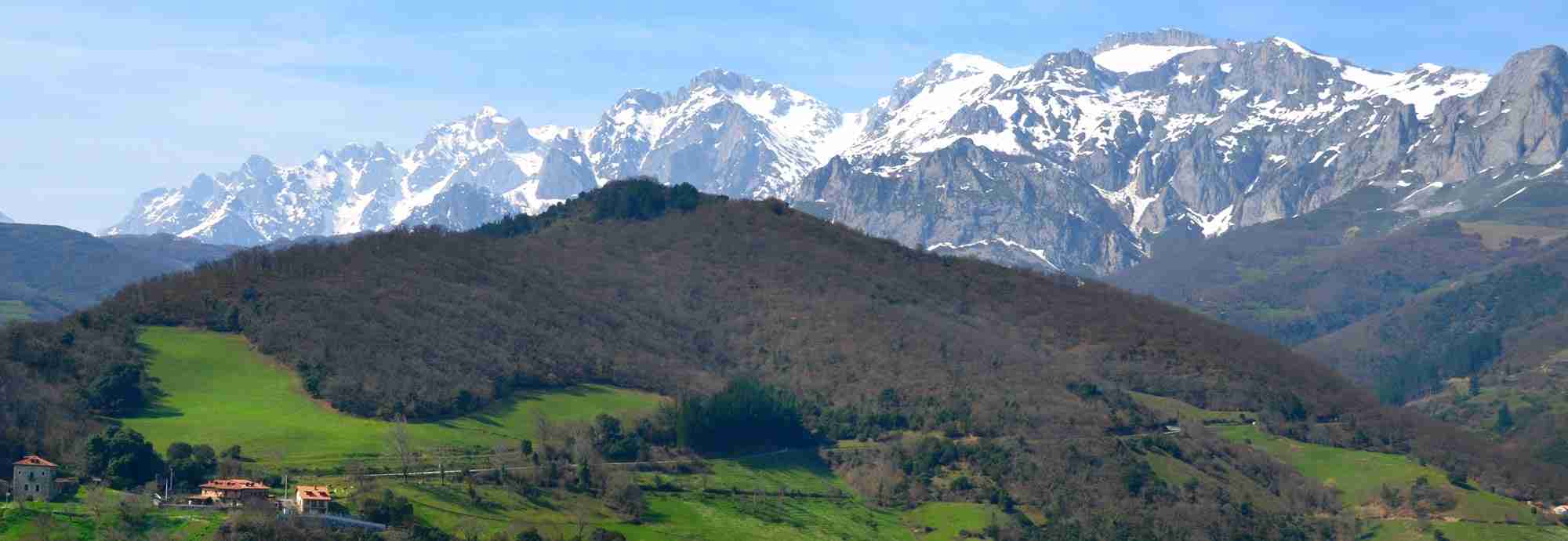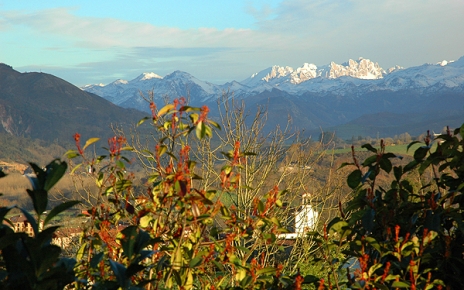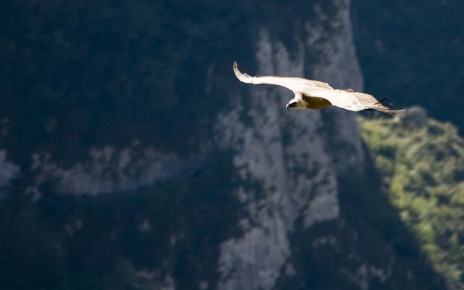Holidays in Picos de Europa
Everything you need to plan the perfect holiday in Picos Mountains: how to get there, the best places to stay, the best times of year to go, and an unbeatable selection of hand-picked holiday villas and cottages.
Find your Holiday home in Picos Mountains
Summary
Rivalling the Alps for mountain scenery, hiking opportunities and snow-topped peaks in winter, and yet only 20 kilometres from the Atlantic beaches of the Bay of Biscay, are the picturesque Picos de Europa.
The mountain range and National Park of Picos de Europa, shared between Asturias and Cantabria, is an ideal choice for a natural experience of Northern Spain.
The eastern Picos in Cantabria are best described by the wonderful area known as Liébana. Read more about: Liébana
Here we focus on Asturias and the classic Picos de Europa at their most spectacular: Covadonga and the high lakes, Cabrales and the Naranco de Bulnes, and then we go deeper: into Ponga.
The Picos de Europa in Asturias became Spain's first National Park in 1918. They comprise several peaks in excess of 2,500 metres, with Torre de Cerredo highest at 2,650 metres.
In the Asturias Picos, you find the favourite Cares Defile walking route, a funicular railway, and exquisite old villages linked by country lanes through green valleys which harbour rich wildlife. Most special of all is the endangered Cantabrian brown bear, but Picos de Europa is also home to the chamois deer, the wolf, the rare capercaillie and a host of raptors.
Did you know?
The name 'Peaks of Europe' is said to have been give to the mountain range by sailors returning home from the Americas. The high peaks would have been their first sight of land on the old continent."
One of the most attractive sides of going to Picos, just relaxing with the views, going on walks, river rafting, exploring the beautiful Asturias countryside and villages, is that a holiday here is so easily combined with the coast.
Beaches along the Dinosaur Coast are natural and unspoilt, and cliff walks complement nicely with the mountain heights.
To enjoy the best of the mountains and remain within easy reach of beaches and fishing villages, we guide you to locations in Sierra del Sueve and Cider Country, where the gate to Picos de Europa opens at Cangas de Onis.
Read more about walks in Sierra del Sueve.
Also known as Piloña after the local river, the area has some of the best accommodation and views.
Another route takes you into the mountains from the coast at Unquera.
Mountain fare in Asturias is always good, always nutritious. And this being Cider Country, there's always that very Asturian experience on hand, complemented by crumbly, blue mountain cheese.
Heading further inland, Ponga Natural Park is a little known and extraordinary expanse to discover.
Overview
VIEWS OF THE PICOS DE EUROPA
One of the best ways to appreciate the mountains is from a modest distance away. The distinctive wedge-shape of the Naranjo de Bulnes and the surrounding limestone peaks are a fabulous sight across the gentle, green and forested slopes of Piloña: Cider Country and Sierra del Sueve. This area is also your route into the Picos.
PILOÑA CIDER COUNTRY
Traversed by the N-634 road that runs from Nava (home to the Cider Museum, of which more anon) in the west to Arriondas in the east, Piloña is a beautifully unspoilt area comprising 24 parishes. It's more like a shire, enchanting to walk and explore. Country lanes follow trout-filled rivers though gorges and wind through wonderfully preserved villages of old stone cottages, valleys with views of the Picos de Europa, traditional homesteads and religious architecture, country homes, woods of beech, chestnut and oak sprouting mushrooms. The hills have abundant populations of deer and wild boar.
ARRIONDAS
Arriondas is best known as the setting-out point for descending the Sella river in kayak, canoe or raft. This small town where the River Sella is swelled by the Piloña river has become a big draw for the number of small operators offering downriver canoe and kayak trips. This has become a popular activity and you'll have no problem hiring a boat if you want to try it. In August, people come from far and wide to take part in the festive International Canoe Race, accompanied by music and street events. You can also organize canyoning and similar outdoor pursuits here, as well as hire mountain bikes. Arriondas has good facilities, including cider houses. There are several bars for evenings out and even a disco. There's also a hospital.
CANGAS DE ONIS
The gateway and hub for the Picos de Europa and the liveliest place in the area. Outdoor activity agencies abound here, offering canoeing, rafting, a rope-and-obstacle park, canyoning, caving and other adventure sports for all ages. Cangas Sunday market is a good opportunity to pick up fresh produce and select from a variety of intriguing (and often pungent) cheeses.
COVADONGA
From Cangas, you enter the Picos proper and a 20-minute drive up brings you to Covadonga, where a cave holds the tomb of King Pelayo, famed for his victory over the Moors in 722 AD that marked the beginning of the reconquest of Spain by the Christians. There's a sanctuary in the cave, dedicated to the Virgin Mary, who is understood to have sponsored the victory. Directly beneath the cave, fed by a waterfall, is a small, beautiful lake.
GLACIAR LAKES
Reaching the cave at Covadonga is by no means the end point of the trip. From here, a high road climbs up to the uncanny atmosphere of the glacial lakes, Enol (1,070 m) and Ercina (1,108 m). The destination is so popular during the summer that cars are restricted and a bus takes visitors up from parking zones along the route. You can also take a bus directly from Cangas de Onis.
CABRALES
Here we are at the heart of Picos de Europa for its best-known walking trail. To get there, take the AS-114 from Cangas de Oni mentioned earlier and drive east, or the same road from Panes and drive west. Either way will take you to the area's focal point, Arenas de Cabrales. The name Cabrales means "cheese" to most Spanish people, but on this occasion we're interested in the locality.
From Arenas de Cabrales, it's 15 minutes by road up to Puente de Poncebos where day-trippers have a choice of the terrific Cares Defile walk or the funicular railway to Bulnes.
CARES DEFILE WALK
The most famous of the Picos walks for good reason, "the one everyone does," the route from Poncebos to Cain passes through the narrow Cares gorge, along tunnels carved into the rock, by the water, over bridges. You won't get lost: the path is well worn and there are always other people doing the same thing. There are some abrupt drops, but it is not hazardous as long as you wear sensible footwear and ensure you don't get dehydrated. The round-trip to Cain takes approximately 6 hours.
FUNICULAR TO BULNES
Poncebos, the starting point for the Cares Defile walk, lies at the foot of the most emblematic mountain in Picos de Europa, Picu Urriellu, known colloquially as the Naranjo de Bulnes. At the base of the mountain, but high above Poncebos, is the tiny village of Bulnes (population: 22). Bulnes is one of the few villages in Spain without road access. It's a very pleasant 3-hour hike, but most people opt for the 7-minute trip to Bulnes on the funicular railway which passes through a tunnel bored into the rock.
From Bulnes, the views are superb. Only trained mountaineers attempt to climb Picu Urriellu. The west face, a sheer 550 metres, is considered one of the most difficult ascents in Spain.
THE DINOSAUR COAST: FISHING VILLAGES AND BEACHES
Some of the best beaches in Northern Spain are strung out along what is popularly known as the Dinosaur Coast, owing to the impressive fossil record found here, including fossilized dinosaur footprints. There are also attractive towns with harbours and seaside villages.
LLANES
One of the favourite coastal destinations in Asturias, Llanes combines historic charm with being a working fishing port. It has more life and tourist facilities than most of the others. There are pretty beaches and behind it rise the mountains.
TAZONES
Tiny Tazones is high on the list if you fancy seeing a traditional Asturian fishing village. It's quaint, but tends to be overrun with tour buses at weekends.
LASTRES
This photogenic seaside town has pretty streets that afford views down the coast. It's very pleasant to simply walk around. It has good restaurants, its own beach and is also close to Playa Griega beach and the Jurassic Museum, a distinct favourite with children.
JURASSIC MUSEUM
Museo Jurásico is very close to Colunga and Lastres and it is signposted when you drive from the Colunga to Playa la Griega beach (see below). A visit to the Jurassic Museum with its mock-up dinosaurs and real fossils can be made even more real and exciting by going down to Playa La Griega and seeing real dinosaur footprints.
LA GRIEGA BEACH
From Colunga, head towards Lastres and you'll soon come to La Griega beach, which is located just before Lastres itself and below the Jurassic Museum.
There is something intimate and charming about this beach (note that occupation in peak season can be quite high) and it is has a very special attraction: walk inland from the beach about 100 metres (along the parking area), turn left to cross the river, and then take a well signposted path (on the right-hand side of the beach as you face the sea). In less than 10 minutes the path will bring you to a small rocky area with large dinosaur footprints.
CUEVAS DEL MAR & SAN ANTONIO BEACHES
Cuevas del Mar is accessed from the village of Nueva, approximately halfway between Ribadesella and Llanes. You can of course stay right here, but an even better option is to then continue to San Antonio beach, which is very natural and unspoilt.
It is very unusual to see the dramatic Picos de Europa (with patches of snow on top) from the beach, but at San Antonio beach it's possible, and we found it fascinating. If you are here towards the end of the day, or when the tide is in, don't miss the bufones! We'll explain. If you walk up to San Antonio chapel on the cliff top and then go left along the cliffs you will hear the sea roar: those are the bufones, either natural sounds made by sea and air coaming the rock, or sea monsters, as you wish... Sunsets are spectacular here and could be combined with an evening drink at the chiringuitos (beach restaurants).
NIEMBRO SEASIDE VILLAGE FOR TORIMBIA AND NIEMBRO BEACHES
Drive to Posada take the small road to Niembro by Barro village. Both beaches are very pretty and popular. Torimbia is partly nudist and it is accessed by foot down cliff steps: the car has to be left at a car park above the beach. It's an extremely pretty place to be for the sunset. Niembro is a high quality beach, again very pretty, accessed directly from parking. At both beaches parking can be tricky in August if you arrive late.
REGOLGUERU BEACH & EL PINDAL CAVE
Included in our guide to the best beaches in Asturias, Regolgueru is a small cove accessed down a steep cliff path. You can also walk ther from the better known beach of La Franca, but only when the tide is out. Close by Rogolguero, you can see Paleolithic cave paintings in El Pindal cave at Pimiango. Open 10 am – 2 pm & 3.30 pm – 4.30 pm Wed to Sun. Closed Mondays & Tuesdays. Free on Wednesdays ;-).
PONGA
We can't recommend too strongly that you also take another drive: south from Cangas de Onis into the Ponga Natural Park area, for a chance to really get off the beaten track. South from Ribadesella or east from Oviedo, a truly marvellous route into the mountain heart of Asturias starts at Arriondas, bordering the Sierra del Sueve. The N-625 follows the River Sella to the old Asturian capital of Cangas de Onis, where you are already in the Picos and scenery of forest and mountain has taken over. But there's more to come. The salmon river and the road continue south, passing up through a gorgeously verdant valley.
Little villages and the surrounding nature just gets more and more beautiful as you head further south in the direction of Riaño (in León province).
At Precendi, by which time you already feel that you have entered another, more natural, world and time, try a brief detour to little Sames (population :71) in its enchanting setting.
You now come to Ponga and one of the highlights of the Picos de Europa, yet one which is unknown to most visitors.
To your left, hidden behind the steep sides of the gorge, wooded with beech, yew, maple and oak are the high peaks of Picos de Europa. To your right, Ponga Natural Park is a forested mountain wildness where deer and wild boar are prevalent, otters and muskrats indicate the health of running waters, and the elusive brown bear finds a refuge from inquisitive human eyes.
The immense Peloño Forest here is a privilege to set off and walk through. One of Europe's foremost mature beech woods with over 200,000 trees, mountain views and rivulets, it is home to chamois, roe deer and wolf, as well as being one of the most important habitats of the rare capercaillie. A walk through the green shade of these woods is a limpid, luminous experience. In Celtic mythology, the beech symbolizes elegant, practical people, and is related to the mother god and fecundity.
If you want to carry on, you can. The road snakes on, always through impressive mountain scenery, passing eventually all the way into the province of León.
BEARS
No visit to Picos de Europa would be complete without a mention of the beautiful and very rare Cantabrian brown bear. A few pairs still manage to survive out in the wilds here. They are zealously protected and a local NGO, La Fundación Oso de Asturias,looks after their habitat, needs and orphaned cubs. You're very unlikely to see bears, which are sensibly shy of humans, but just knowing they are there makes a difference.
BEST OF THE REST
People of the Picos
The Picos de Europa mountains are thrillingly beautiful and doubly interesting for being a National Park with habitations: there are several hamlets and villages which coexist in successful harmony with the protected alpine landscapes.
Take the train along the coast
Asturias has a good, reliable and inexpensive light railway system (FEVE), a nice change from the roads that allows your driver to take a day off. The network is administered by the national rail operator RENFE.
Rent a bike in Llanes
Very close to Llanes FEVE railway station is a bicycle hire shop. You can cycle along a track as far as Poo, on the outskirts of Llanes to the west. From Poo, a signposted single-lane path continues along the coast for about 15 km.
Also in Llanes is an activity agency called Torimbia Ocio Natural. As well as bicycle hire, they offer other activities like horseriding, hot-air balloon flights, canyoning and much more. You can check these by visiting their website torimbiaocionatural.es
Fishing
For approximately 13 euros, EU citizens can obtain a tourist fishing permit from the Asturias government via its webpage.
Markets and Fairs
For shopping or simply an interesting insight into the local culture, visit the village markets and fairs. Of special note is Cangas de Onis market held on Sunday mornings.
Other wildlife and birdlife
The Picos de Europa are home to a vast wealth of wildlife, not just bears. There are a few wolves, and plenty of chamois and roe deer, wild boar and foxes. In the woods live partridges, mountain cats, the black woodpecker, the dormouse, squirrels and genets. A few capercaillie still survive in the Asturian Picos.
More than a hundred varieties of birds inhabit the mountains and valleys. star attractions are the raptors: Golden Eagle, Short-toed Snake Eagle, Egytian Vulture, Griffin Vulture and Bearded Vulture. You can also spot Red-billed and Alpine Choughs, the Dunnock, and Pipit.
Birders will be delighted to know that spotting trips are a speciality of English-speaking ornithologist Javier Gil.
Nava Cider Museum
The town has 17th century churches and La Cogolla Palace to its name, yet its best-known landmark is the Cider Museum. Open every day except Monday, it's the perfect place to learn all about Asturias' emblematic drink, which you can also read about in a Rustical Travel article Of cider and cheese. You can visit their website to check opening times and fares on museodelasidra.com
Espinaredo
Situated 6 km due south of Infiesto town, this little village represents one of Spain's beauty spots. It nestles at the foot of Piloña's Sierra Bedular, where it is home to 164 inhabitants. Espinaredo's recreational forests with its picnic areas, easy walks, cycle trails and challenging treks make it an exciting destination for a holiday or daytrips. The village breaks the records for traditional Asturian hórreos (grain stores: over thirty of them) and has a clean-running river. When you get to the village, park by the square, opposite the bar, and go for a wander. Afterwards, get back in the car and continue further on the same road along which you came. You will eventually come to La Pesanca picnic area. Park your car here and walk up the track to find a good spot by the river. Keep an eye out for an interesting place for wild swimming, you'll will find one! We found a waterfall with crystal clear water for a swim here.
FOOD AND DRINK
Mountain folk expect you to have a hearty appetite and servings at restaurants are generous indeed. The staple par excellence is fabada is a rich chick pea stew flavoured with pork. Beef steaks are excellent and there is often fish and seafood on the menu.
Light, dry Asturian cider is a culture all to itself, requiring a skilled decanting from above head height into the glass to aerate and lend it its full fresh tastiness. Natural cider factories are mostly located in the low-lying Cider Country in and around Villaviciosa, where the apple orchards are to be found, rather than up in the Picos.
The cider is classically accompanied by Cabrales cheese, spicy and creamy, which can come as a topping on a ración (a portion) of potatoes (patatas al cabrales). Another, much rarer cheese well worth a special mention is Gamonedo. Gamonedo del Puerto comes from the mountain pass (not from the valley). This cheese is highly regarded by the very best Spanish delicatessen shops. It's normally available in small quantities only following sale at auction at very high prices. Rustical Travel has seen this cheese on sale in Madrid at over 60 euros per kilo. It is hand-made by shepherds in their alpine cabins at remote locations high up in the Picos de Europa mountains, not far away from the the snowy peaks. There is no car access to these remote locations and few sheperds to carry on this demanding ancient tradition, hence the price and the scarcity, but you may be lucky and find some in PIcos. Gamonedo is only available end of August, beginning of September, when the shepherds descend to the valley before the autumm starts.The flavour is completely extraordinary: you can simply taste the mountains...
Even small villages in Picos de Europa often have a bar or restaurant where you can order meals, although self-catering is also an ideal option for holidays here. It's very common to find small delicatessen or village supermarket that sells good local produce that you can take home or make into a picnic for days out.
Climate
The Picos de Europa mountains form a high-altitude massif rising rapidly from the nearby Atlantic coast to 2,600 metres above sea level. The immense conglomeration of the Picos sierras divides Green Spain from the continental climate of Spain's dryer interior.
The mountains range across three regions of Spain: Asturias to the west, Cantabria to the east, and Leon to the south.
Apart from the obvious divergence between conditions high in the peaks and down in the valleys, where most habitations are to be found, there are significant local differences in climate and generally speaking, the nearer to the coast, the milder the climate thanks to the maritime influence.
The more remote inland interior, in Leon, loses this influence and the climate turns more continental. Summers are dryer and temperatures more extreme, nights especially are colder and the winter longer.
Fortunately, the holiday destinations of Picos de Europa in Asturias are in the milder zone, where valleys provide access to the sea.
Rain is concentrated in the period from November to May, but there's a chance of rain any time of year. From November to March, the Atlantic fronts bearing humidity from the ocean make rainfall commonplace. The mountains act as a natural barrier, retaining clouds which release their cargo of moisture on the land. It means that the Asturias Picos are slightly wetter and a deeper green than the Cantabrian Picos further east.
June, July, August and September tend to be much dryer, but we still advise light rain gear for holidays in Picos de Europa. Weather patterns means that conditions are changeable. Even in the hottest month of August, heat can produce afternoon storms, although these tend to come and go quite quickly.
You do, nonetheless, have excellent chances of sunny weather during the whole summer period in the Asturian Picos, even if not as dry and warm as the unique area of Liébana in the Cantabrian Picos, whose microclimate is more clement than most other areas in Northern Spain.
Fogs are not uncommon in summer months. Occasionally, you'll find that sun and fog alternate between low and high-lying ground. When this happens, you can look down from lovely sunny conditions in the high mountains to a thick cloud blanket in the valleys. The reverse is not unusual, either. Coastal areas can clog with fog and clouds while the entire Picos de Europa remain clear and sunny.
Cold weather and snow is much less frequent in autumn and spring than in winter. The Picos can have delightful springs with plenty of sunshine, usually alternating with days of inclement weather, but each year is different.
In the autumn, southern winds can dominate, creating breathtaking scenery in Picos: deep blue skies and stable weather that can last into early October.
When can I see snow?
From November to March, expect the high peaks to cover over completely in thick snow. Snow doesn't affect the villages in the valleys that much, though. In April, snow melts fast on the lower reaches of the mountains, leaving behind beautifully green fields and alpine pastures.
You won't find proper glaciers, but at the highest altitudes the snow is perennial, so even in summer you will see patches of white topping the peaks.
PICOS DE EUROPA CLIMATE SUMMARY
The weather can be changeable any time of year and there are marked variations between high locations and villages which are generally situated at low altitudes.
The western, Asturian, Picos tend to be cooler and more humid, greener than their Cantabrian counterpart.
Summers, from early June to late September, are significantly dryer than winter and early spring months. Autumn, too, can often offer good weather in Picos de Europa.
On average, rain falls 50% of days during the entire year, although one must take into consideration that the precipitation is concentrated in months from November to March, and still, if less so, in April and May.
To the north, nearer the coast, the climate is milder, with temperatures regulated by maritime influences. To the south and the interior, where settlements are more sparse, the massif experiences more extreme heat and cold, as well as dryer conditions.
Maps
Getting there
AIRPORTS FOR PICOS DE EUROPA
The nearest airports for holiday villas and cottages in Picos de Europa are Asturias Airport (OVD) and Santander Airport (SDR) with the drive taking typically between 1 hr 15 mins and 1 hr 45 mins.
Alternative:
The other possibility is Bilbao Airport (BIO), which is another 1 hr away.
FERRY PORTS FOR PICOS DE EUROPA
If you're coming from the UK or Ireland and want to bring your own car, Picos de Europa are served by ferry ports at Santander and Bilbao. The crossing takes at least 24 hours, but it does allow you to bring all that extra luggage you couldn't take on the plane, and avoid car hire.
Santander ferry port is the next nearest, between 1 hr and 1 hr 45 mins from holiday villas. The drive from Bilbao ferry port takes about 2 hrs 30 mins.
Ferry routes
Operated by brittanyferries.co.uk on impressive ships in their modernized fleet. You can also bring a pet with you in onboard kennels or pet-friendly cabins.
• Portsmouth - Santander
• Portsmouth - Bilbao
• Plymouth - Santander
CAR HIRE
Holiday villas in Picos de Europa tend to be in secluded locations which are not served by buses and a car is generally essential. Unless you're taking the car ferry to Santander or Bilbao, you'll need to rent a car.
It's practical, convenient and needn't be expensive. It often works out cheaper than taking a taxi and is then invaluable for shopping, eating out, visiting places of interest, days out at the beach, and making an easy return trip at the end of your stay.
If your villa is up a track, be sure to rent a vehicle with good clearance. This means most normal cars: simply don't be tempted by a low-slung sporty model.
The road network in Picos de Europa is good and there are some very scenic routes. Bear in mind that country lanes are often narrow, so we wouldn't recommend a bulky vehicle. And for driving up to the high lakes at Covadonga, you're better off in a car with decent uphill power (not the smallest budget option).
Car hire offices are situated at all three airports for the Picos: Asturias, Santander & Bilbao.
Driving times from airports your holiday property are shown on the villa's property page. You will receive a map with detailed directions to your villa as one of your holiday documents from Rustical Travel.
Rustical Travel doesn't have a professional arrangement with any particular car hire company and we suggest you shop around for car hire using a broker such as rentalcars.com or similar.
It's easy to compare prices of rentals with companies that operate at the airport you fly into, and all the reputable agencies have online payment for advance booking these days.
You don't have to use the broker. If you prefer, you can check the car hire companies own websites, compare prices, and book direct.
Parking is free of charge in the towns and villages of the Picos de Europa.
PUBLIC TRANSPORT
Public transport in Picos de Europa is limited, with few buses. For convenience and all practical purposes, a car is a necessity in rural areas.
However, the small FEVE train is a pleasurable and inexpensive way to take a journey for a day out in Asturias, as long as you're not in a hurry. It trundles along, stopping at little stations along the way. The rail link goes from the coast all the way up through a high valley to the Picos village of Arriondas, from where the mountains rise. You can check timetables on the website for the national Spanish rail operator, renfe.com.
To reach Bulnes at 650 metres above sea level in the central massif of Picos de Europa, there is a funicular railway or a path, but no road.

Picos de Europa

Ponga village, western Picos
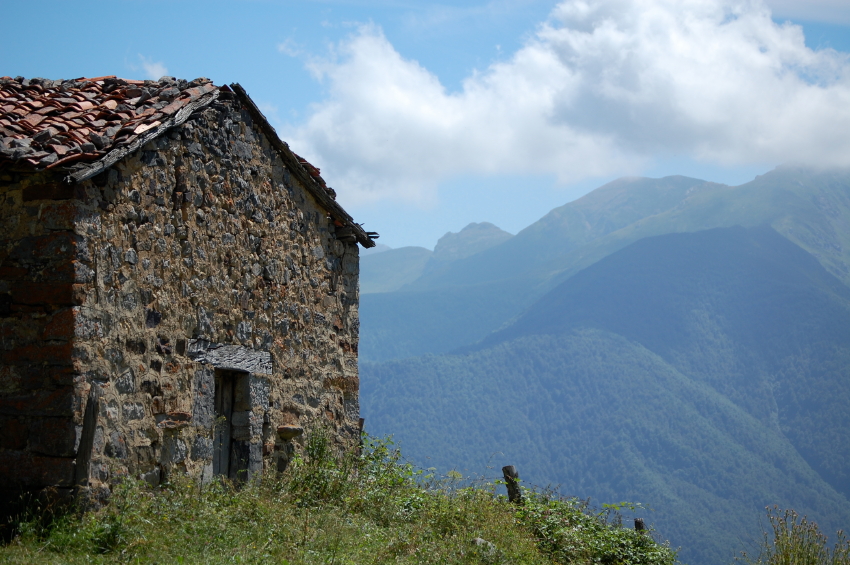
Shepperd´s cabin in high altitude

Views from one of our holiday properties: AT23

Tradition in Bulnes

Farming near Potes

Country Living
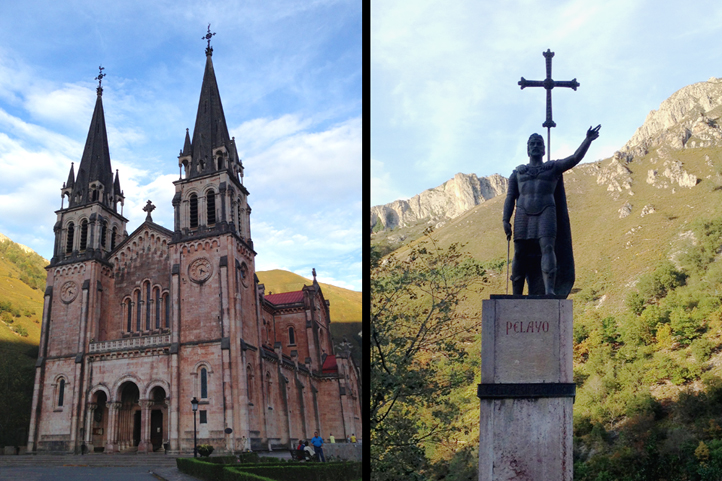
Covadonga Sanctuary and Don Pelayo
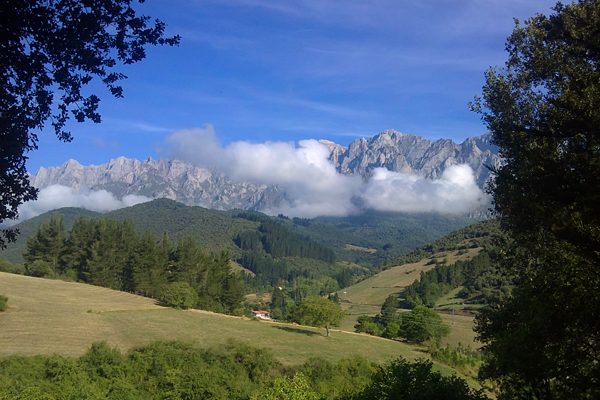
Picos views from Jano peak

Eastern Picos de Europa

Hermida Gorge

Llambrion Peak is over 2,600 metres high!
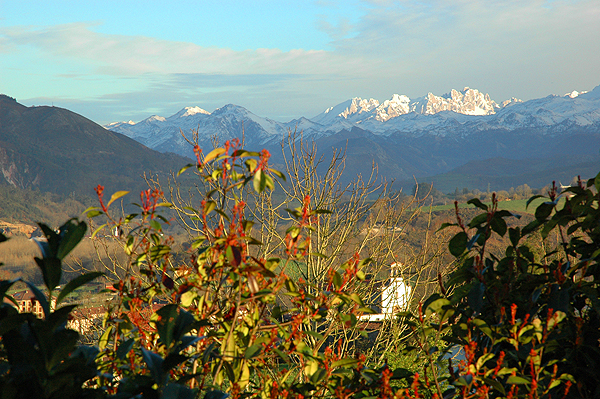
Peña Santa de Castilla from Arriondas

Peña Santa de Castilla in summer with some snow patches

Somewhere in Picos de Europa

Picos views from the coast (Pimiango village)
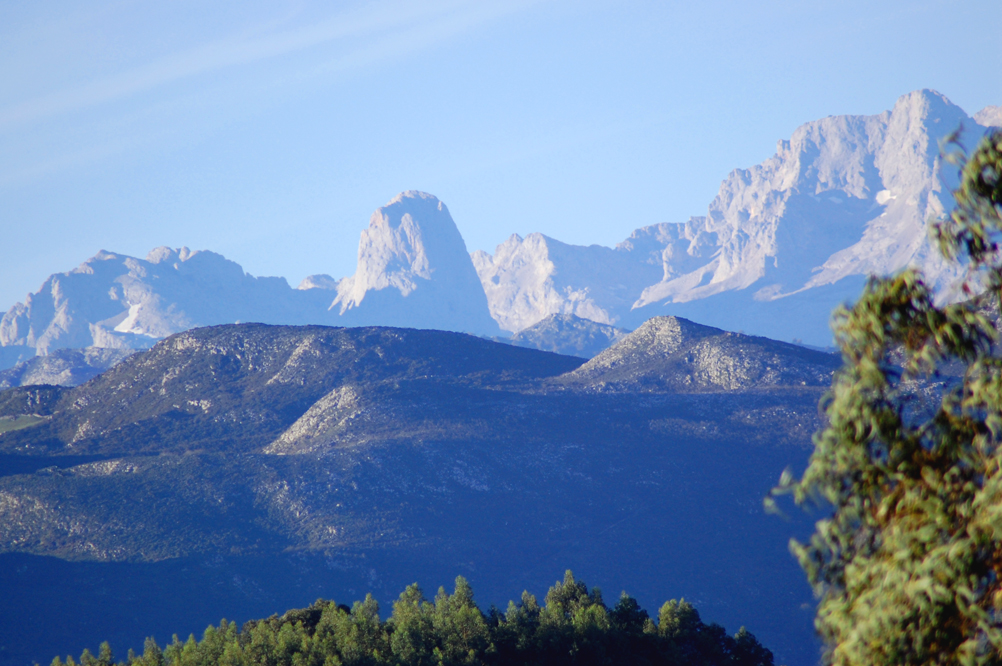
Picos seen from the Cantabrian Coast
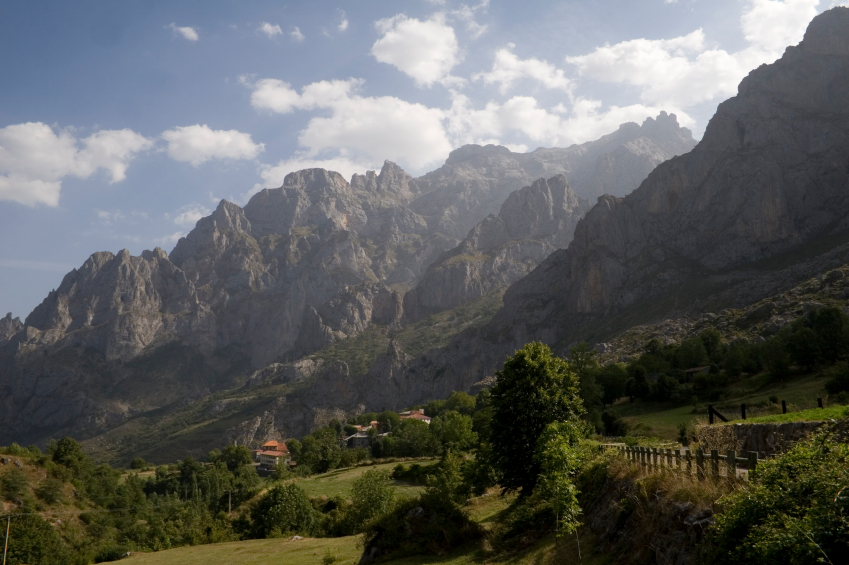
Picos scenery is always dramatic
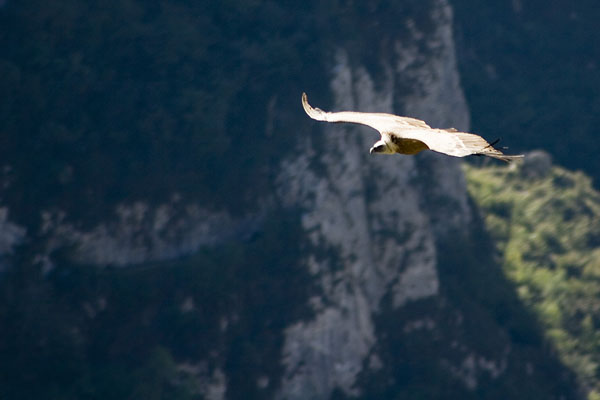
Eagle in Tresviso

Walking in Tresviso

Traditional Picos arquitecture

Dairy local tradition

Medieval local fayres are very popular
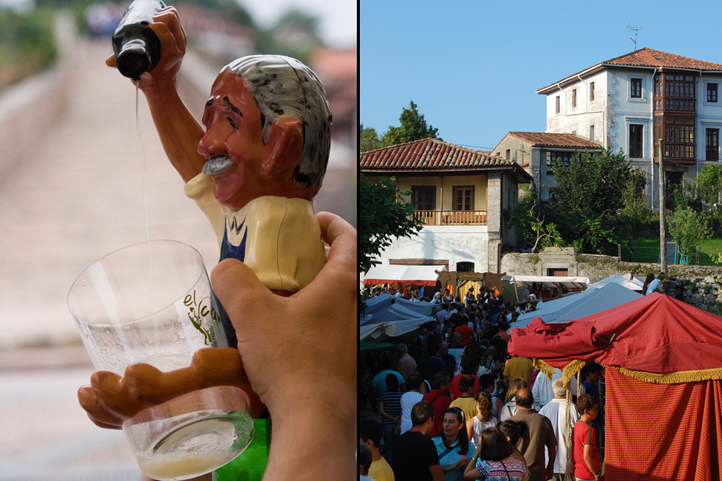
Live like a local

Picos in early April | Kids love Picos de Europa!

























